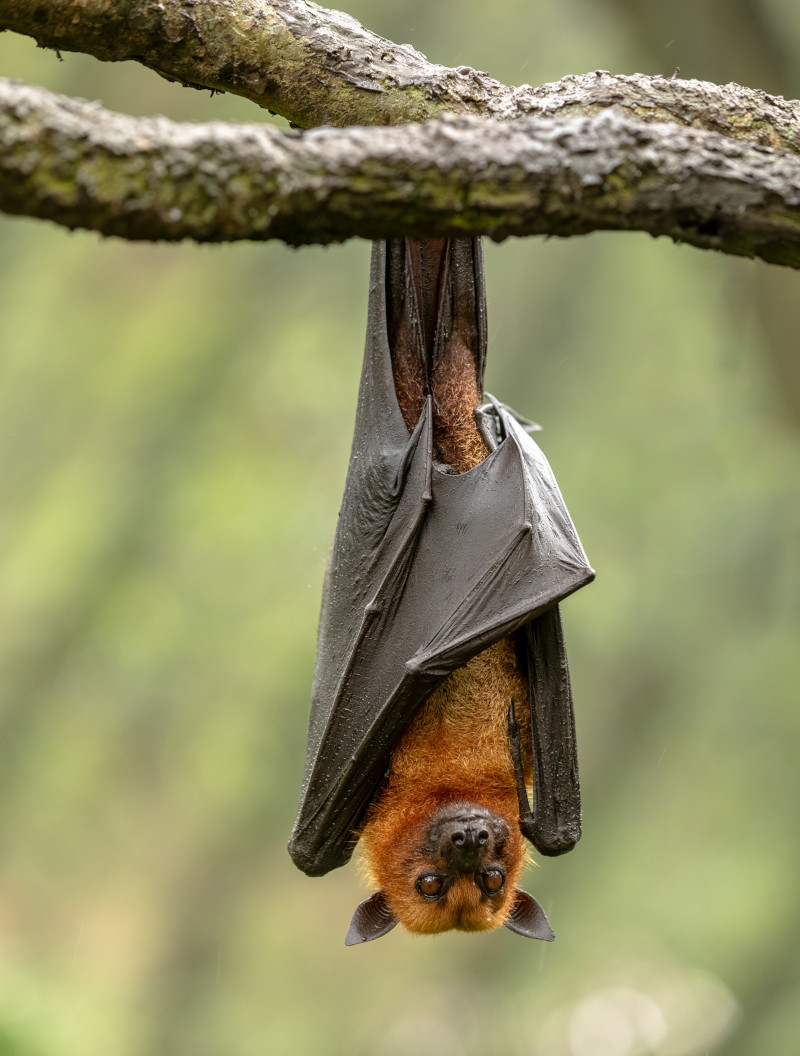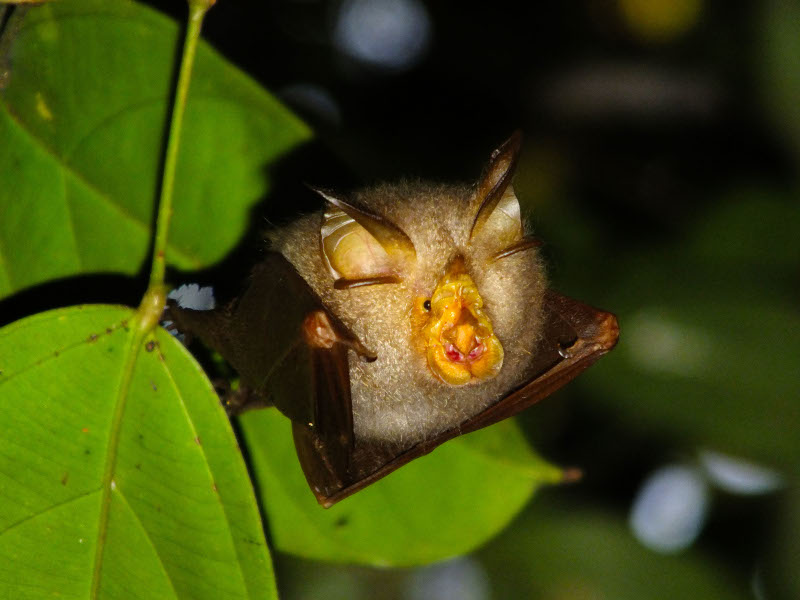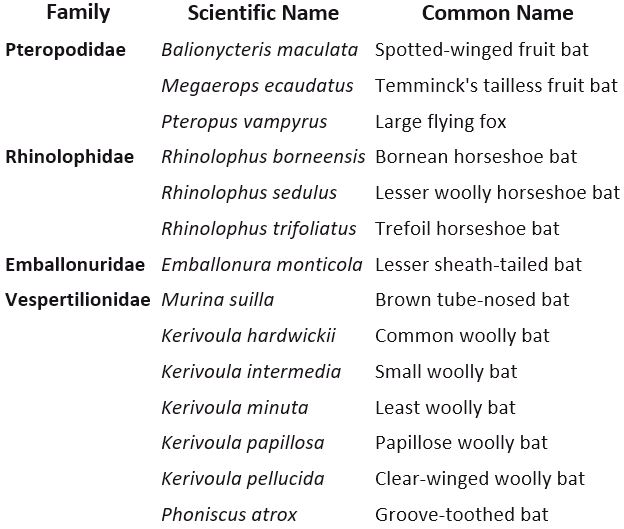August 07, 2025
Bats can broadly be split into one of two distinct groups: the megabat flying foxes, which are all fruit and nectar feeders; and their microbat relatives, the insectivorous bats. But what sets them apart? And what similarities do they share? In this article, we’ll provide answers to these questions, while also revealing why these species matter to forest ecosystems and what is being done at Restorasi Ekosistem Riau (RER) to protect them.
Mega or Micro? Flying Foxes and the Bat Family
First up, let’s deal with the taxonomy: Flying foxes are not just cousins of bats – they are bats! All bats belong to the order Chiroptera, which is divided into two main suborders: Megachiroptera, which includes the megabats (such as flying foxes); and Microchiroptera, or the microbats (which covers most other bat species).
Some newer classifications of this family now also refer to Yinpterochiroptera (which includes flying foxes and a few microbat families) and Yangochiroptera (which covers most other microbats). But for simplicity, the traditional “mega vs. micro” split is still widely used (and that’s the classification we’ll follow in this article).
The large flying fox (Pteropus vampyrus) belongs to the megabat family. They can be found across various parts of South Asia, Southeast Asia, Australia, East Africa, and several oceanic islands in the Indian and Pacific Oceans. They roost in large colonies around mangroves, forests, and coastal lowlands. Microbats, by comparison, are even more adaptable and widespread – they can be found on every continent in the world except Antarctica. They tend to roost in caves, tree hollows, cliff overhangs, and even in the eaves of abandoned buildings.

Size and Sensory Differences
As the name suggests, large flying foxes are some of the biggest bats in the world, with a wingspan of up to 1.5 meters (5 ft), and a body measuring 27–32 cm from nose to tail. These impressive aeronauts tip the scales at around 1.1 kg (2.4 lbs), making them one of the world’s largest flying mammal species (and the heaviest in Southeast Asia).
And their appearance offers a clue to both their sensory abilities and their hunting techniques. While many bats have evolved complex facial flanges, hooked noses and elaborate ear flaps for the purposes of echolocation – some of which may appear grotesque to human eyes – flying foxes rely on their keen eyesight and sense of smell to find food. This makes them appear cuter or more familiar to us, but also gives them an advantage in their daily activities.
Differences in Diet: Fruit-loving Flying Fox vs Other Bats
Flying foxes are megabats, which feed only on fruit and nectar. As such, they play a vital ecosystem role in the forest, through both pollination and seed dispersal via their droppings, which are spread far and wide on their flights – flying foxes can travel many kilometers each evening in search of food.
Microbats, on the other hand, have been classified as insectivores, carnivores, sanguinivores, frugivores, and nectarivores. Unlike flying foxes, they use complex, high-frequency sounds to navigate and hunt for insects in the darkness. Their echolocation skills are so highly developed, they can hunt flying insects on the wing, and successfully catch hundreds – or even thousands – in one night. This makes them essential pest control agents in forest ecosystems. Like the flying fox, their droppings are also essential to forest health, as bat feces – known as guano – are especially rich in nutrients, which promote new growth on the forest floor, and can even sustain whole ecosystems on the floors of caves where they roost.

RER: A Refuge for Bats and Flying Foxes
The RER project area is incredibly biodiverse. The most recent survey documented no fewer than 838 species of flora and fauna, which included 58 insect species and 78 mammals, including 14 species of bats and flying foxes (see below). The large flying fox is classified as Endangered on the IUCN Red List of Threatened Species, making their protection especially important. A healthy forest is the foundation of a thriving ecosystem and the basis for complex food webs. In RER, the presence of so many flowering and fruiting plants supports a thriving insect population, which in turn provides food for a wide array of bat species.

In locations like Tasik Lakar Lake, we often spot flying foxes roosting in large colonies or setting out at dusk in search of a meal, while smaller bat species like the trefoil horseshoe bat (Rhinolophus trifoliatus) are one of several microbat species often recorded during night surveys. The project area provides an essential refuge for these creatures, as the flying fox in particular is listed as Near Threatened on the IUCN Red List due to habitat loss, hunting, and human-wildlife conflict with farmers. In RER, they are free to forage, and thrive here just as nature intended.
Why Flying Foxes Matter to Forests
As pollinators and seed dispersers, flying foxes play an important ecological role in tropical forest ecosystems. When feeding on fruits and flowers, they carry pollen between trees and disperse seeds over long distances – often many kilometers away from the parent plant.
This makes flying foxes critical agents of forest regeneration, particularly in fragmented or recovering landscapes like peat swamp forests. By spreading seeds across wide areas in their droppings and carrying pollen between flowering plants, they help maintain plant diversity, restore degraded zones, and build bridges between remote patches of forest. This daily delivery service is essential to ensuring long-term ecosystem resilience.
How RER is Protecting Flying Foxes
With that in mind, protection for flying foxes is vital to conservation and landscape restoration approaches. RER’s conservation model combines habitat conservation with regular monitoring and mitigation of common threats such as habitat destruction and conflict with humans.
RER’s integrated PARM approach, comprising Protection, Assessment, Restoration, and Management, ensures that forest areas are safe from disturbance and rich in native food sources such as flowering and fruiting trees. By safeguarding these habitats, RER provides flying foxes with the roosting and foraging grounds they need to thrive.
RER also works with local communities to reduce human-wildlife conflict and prevents hunting or disturbance of key species like flying foxes, which are sometimes targeted for bushmeat or displaced by land-use change in other parts of Southeast Asia.
Flying foxes are not just forest dwellers; they’re forest builders. Their nightly flights help regenerate the very ecosystems that shelter countless other species, store carbon, and support the livelihoods of local communities. By protecting flying foxes and the forests they depend on, RER is contributing to the resilience of one of Southeast Asia’s most critical peatland ecosystems.
To find out more about our ongoing restoration efforts, please explore our website.